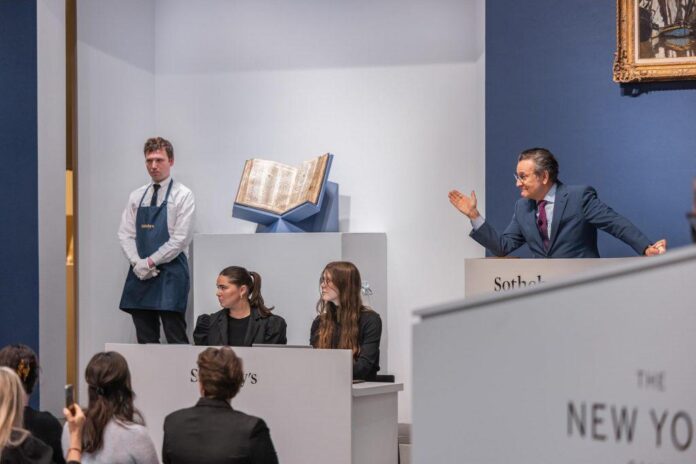The Bible may be the world’s most produced book, but there few—if any—quite like the Codex Sassoon. Produced by a single, unknown scribe in the Levant around 1,100 years ago, it disappeared for 600 years before reemerging in the 20th century as the earliest and most complete Hebrew Bible.
Nearly a century on from being acquired by British bibliophile David Solomon Sassoon for £350 (around $35,000 today), the Bible sold on May 17 at Sotheby’s New York for $33.5 million—rising to $38.1 million with the buyer’s premium. The buyer was ambassador Alfred H. Moses and is being gifted to the ANU Museum of the Jewish People in Tel Aviv. The result lands in the lower end of its $30 to $50 million estimate.

The Codex Sassoon had a pre-auction estimate of $30 to 50 million. Photo courtesy of Sotheby’s.
In preparation, the auction house said few objects could claim such monumental significance, the Codex Sassoon being a foundational cornerstone to civilizations and communities around the world. Led by auctioneer Ben Doller, the sale, however, didn’t quite match the hype. After an initial flurry of bids swiftly carried the price from $26 million to $33 million, there was a prolonged lull with the final, winning bid coming in by phone after a delay of several minutes.
Nonetheless, the price makes the Codex among the most expensive rare books and manuscripts ever sold and places it in between the $30.8 million Bill Gates paid for Leonardo da Vinci’s “Codex Leicester” and the $43.2 million Ken Griffin shelled out for a first printing of the U.S. Constitution.
“It was my mission, realizing the historic significance of Codex Sassoon, to see that it resides in a place with global access to all people,” Moses said in a statement. “It will be preserved for generations to come as the centerpiece and gem of the entire and extensive display and presence of the Jewish story.”
Ahead of the auction, Sotheby’s had taken the Codex Sassoon on a whirlwind publicity tour, giving people in London, Tel Aviv, Dallas, Los Angeles, and New York the chance to see a text that had only been shown once publicly at the British Museum in 1982. The Codex was, Sotheby’s proclaimed in the run-up to the auction, of “incomparable presence and gravitas.” Collectors clearly were not in full agreement.

Codex Sassoon is the earliest and most complete Hebrew Bible. Photo courtesy Sotheby’s.
Although Dead Sea Scrolls rank as the oldest discovered biblical manuscript, the third century B.C.E. text is far from complete. The Codex Sassoon forms something of a vaunted Biblical trinity alongside the Aleppo Codex, which was created around 930 C.E. but is missing 40 percent of its pages, and the Leningrad Codex, which is complete and dates to 1008 C.E.
The Codex Sassoon measures 12 by 14 inches with the pages made from more than 100 animal skins held by brown leather binding dating from the beginning of the 20th century. Part of the Codex’s scholarly value stems from the bridge it offers from early fragments of Biblical parchment that have been discovered through to the early Medieval period. Full Hebrew Bible codices don’t appear until the 9th century with oral traditions having taken precedence.
The Codex Sassoon arrived at Sotheby’s courtesy of Jacqui Safra who bought it 1989 for $3.19 million.

























